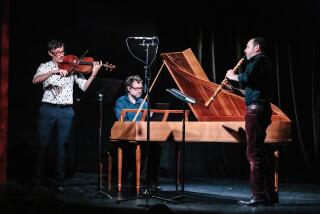Keller Quartet Shows Strength in Bartok
- Share via
String quartets tend to be one of two kinds. The first is an ensemble of four strong individuals who agree to collaborate on a project but maintain their distinct voices.
The second is a group that submerges its individual personalities for the sake of the ensemble, letting the first violinist perhaps act as a primary spokesperson.
The Keller Quartet, which made its California debut Sunday in Beckman Auditorium at Caltech in Pasadena as part of its first North American tour, is a quartet of the second type.
This isn’t to say that first violinist Andras Keller hogged the spotlight or that the ensemble approach taken by him and his colleagues--violinist Janos Pilz, violist Zoltan Gal and cellist Otto Kertesz--didn’t suit all the music.
Both Ravel’s Quartet in F and Bartok’s Quartet No. 5, with their palette of colors and textures, work very well as ensemble pieces.
Beethoven’s Quartet in E-flat, Opus 74 (“Harp”), with its opportunities for internal arguments, agreements and commentaries, fares less happily.
The Keller approach yielded warm, mellow and generally mild Beethoven--the pizzicati, of all things (which give the work its unauthorized subtitle), providing the strongest individual voicings. The piece sounded earlier than it is.
Ravel’s Quartet, on the other hand, with its shifting, coalescing and dissolving thematic material, emerged with subdued sweetness and sensitivity.
Best of all was the Bartok No. 5, in which the musicians demonstrated a special affinity. This was not surprising because of the quartet’s Hungarian roots--like Bartok, they studied in Budapest, where the work was composed, forming the quartet in 1986 while they were still students at the Franz Liszt Academy of Music in that city.
Here they played with aggregate aggressivity and spectral eeriness, as called for. It was remarkable.
The concert was part of the 93rd season of the Coleman Chamber Concerts.
More to Read
The biggest entertainment stories
Get our big stories about Hollywood, film, television, music, arts, culture and more right in your inbox as soon as they publish.
You may occasionally receive promotional content from the Los Angeles Times.










